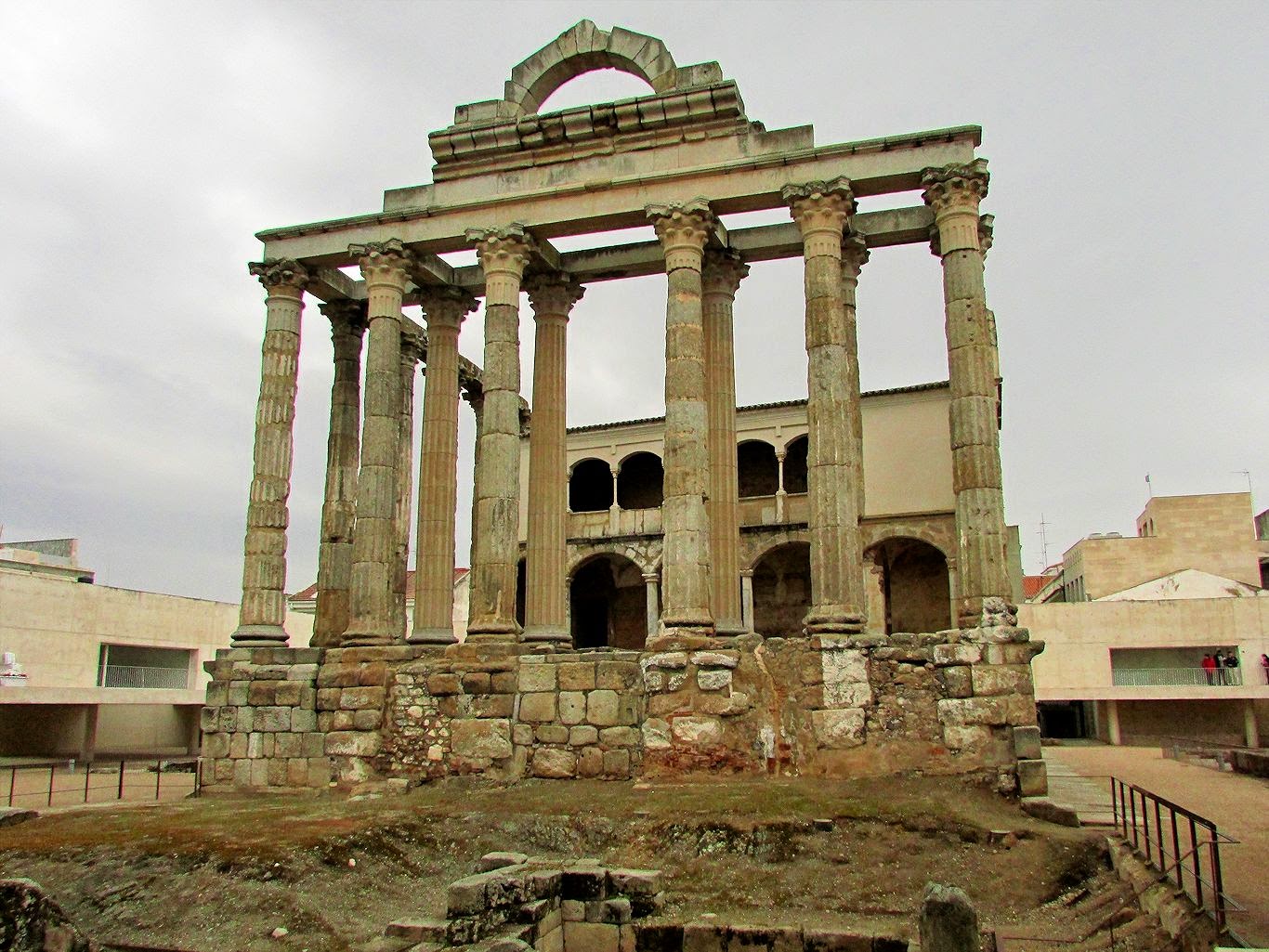We took off on our walking route to get away from the area and stopped in for a café at a normal bar/bake shop a couple streets away which is frequented by locals. After a much appreciated café we continued on our walking route.
There are so many excavated Roman ruins in Merida, there is even Roman snow wells. These are three tanks built into the ground which are connected by channels and used to store snow. Then it was onto the Forum which was located at the intersection of the two main streets in any Roman city, where the decumanis and the cardo intersect. The Forum was a public space which always held a temple at the back wall.
The portico, built in the 1st century AD has been restored. The colonnade, with Corinthian capitals, is decorated with huge medallions with heads of Jupiter, Amnon and Medusa along with caryatids, which the Romans copied from the Greek Acropolis in Athens.
The Temple of Diana, which is actually a temple to the Imperial cult, was built of granite in the usual Roman style with a high podium, frontal facade with an interesting semi-circular pediment, porch, and surrounded by a colonnade.
The Moors built a palace on the site and altered the temple, the high podium seems to have been utilized for defensive purposes as this is a high point in the city as well. It may have housed the governor until the Alcazaba was built.
In the 15th century, a Renaissance palace was built inside the temple, there is evidence of both Roman and Visigothic building materials in the construction. The palace looks absolutely horrific inside the temple, but it did aid in preserving the temple. It is a real mishmash of cultural building styles, with both Gothic and Mudejar elements in a Renaissance Palace inside a Roman temple along with Visigothic columns and capitals.
Our walk then took us to the ruins of a large Roman villa, located outside the Roman city walls, it is referred to as Mitre House. The design follows the usual large domus as we have seen in Italy, with an atrium, colonnaded courtyard, triclinium, cubiculum, Roman wall painting etc.
We were then off to the river and since it was after 3:00 we had lunch on a park bench near the Roman bridge. After a walk along the river we crossed the modern Lusitania bridge, walked along the river on the other side and then crossed over the Roman bridge which is only open to foot traffic. The Roman bridge has been heavily restored over the centuries - in the 17th century, they used granite blocks from the theatre to rebuild the bridge.
The Moorish Alcazaba, built in 835 AD, sits on a hill overlooking the Roman bridge. The Alcazaba is the only Moorish building that has survived in Merida, although excavations have revealed other buildings from the Moorish period which were built over Roman and Visigoth buildings, utilizing building materials from those periods. The Alcazaba had 25 towers at one time, some were built after the Christian reconquest.
The most interesting feature in the Alcazaba, is the only surviving Moorish building within the walls, an underground cistern with double stairways leading down to the water tank. It is poorly lit and after coming in from the bright light outside it was practically impossible to see our way down the irregular stone steps. But we headed down and by the time we got close to the bottom we could at least see the way. There are some wonderful Visigothic pieces used in the construction of the cistern, they look totally out of place as they would have been used in some important Visigothic building.
We then walked to the Visigothic museum which is housed in an old church. There was nobody there but the attendant, who stood high up in the former alter area at the front and watched us the whole time we were there, which was a bit creepy. I think we would have had quite a time pilfering a slab of marble, so I don’t really know why she took up her position.
The Visigothic museum was a total gem, loaded with Visigothic pilasters decorated with plant motifs, clusters, cane patterns and fruits. There was also display cases with pottery, jewellery, tools and utensils etc.
Feeling rather saturated at this point we headed for the Plaza de Espana and had a café con leche at a sunny table in the plaza. Then it was off to the aqueducts, there were three sets of aqueducts bringing water into Merida during Roman times. The aqueducts carried water from reservoirs and springs outside the city. The Romans were accomplished dam, aqueduct and water tower builders for the distribution of fresh water to the city.
Finally we reached our last stop, the Roman Circus, which was the stadium used for chariot races. The circus seated 30,000 spectators and had six bays on each side of the parade entrance which held the charioteers. The entire ground plan of the circus is visible today, which is quite rare. The area in the middle is called the spina, which was richly decorated. The chariots would run seven laps around the spina with the finishing lines at either end of the spina. There is access to the whole circus area so we walked around the spina.
We then walked back to the parking lot and drove back to Trujillo. We plan to complete our walking tour of Trujillo today and have a bit of an easier day.
The Forum
Temple of Diana
Temple of Diana with the Renaissance building stuck into the cella
Mitre House Courtyard
Moorish cistern with Visigothic pilasters
Stairway leading down to the cistern
Visigothic artifacts in the museum
Visigothic pilaster in the museum
Roman Los Milagros Aqueduct
Beautiful bird near the aqueduct
Los Milagros Aqueduct
Rabo de Buey-San Lozaro Aqueduct
Roman Circus













No comments:
Post a Comment